A hyena’s birth is no laughing matter. A spotted hyena, in particular, has one of the strangest births you may see on a safari in Africa.
This carnivorous wild animal gives birth through a narrow birth canal. The birthing process is most dangerous for first-time mothers and can result in the cubs’ death from suffocation.
Want to know why the spotted hyena’s birth is so risky? Continue reading to discover more about the hyena’s difficult birthing process.
How Do Hyenas Give Birth?
Of the three hyena species, the spotted hyena, Crocuta crocuta is the only one to have a pseudo penis.
It has the most challenging birthing process, and unlike the brown hyena and striped hyena, it gives birth to young who have open eyes.
After an average of 110 days of gestation, the spotted hyena mother gives birth to between two and four cubs. The 1-1.5 kg cubs arrive through a 1.54 cm (1 inch) wide birth canal.
The birth canal resembles the genitalia of male hyenas. It is, in fact, the female hyena’s clitoris.
The brown hyena gives birth to a litter of 1-5 cubs which weigh 1 kg at birth. The cubs are born following a 90 day gestation period.
Similarly, the striped hyena has a gestation period of 90 days and gives birth to between 1 and 6 cubs.
How do hyenas mate?

Female spotted hyenas also have a tough time mating. The placement of the female and male reproductive organs makes the process challenging. Hyena reproduction can only take place when the female hyena accepts sex.
The female holds the dominant position in hyena social structures. Males are subservient and tend to leave their clans to join a cackle of females.
The female is fertile for three days (per year), during which she will attract and mate with a male.
The mating relationship between spotted hyenas is polygynous, with males performing a bowing display to females before mating. Males appear timid and retreat immediately if the female shows any aggression.
The female’s phallus is slack during mating, with the male achieving intromission by sliding its haunches under the female.
Hyena in labor
While most animal births in the wild are awe-inspiring, hyena labor stories can be particularly noteworthy.
Mothers typically give birth in an isolated den near to the clan’s lair. However, a cub born recently alongside a road in the Kruger National Park gave visitors a unique sighting.
Katie Adams, a wildlife conservation graduate, witnessed the hyena giving birth and mentioned that the mother appeared agitated and uncomfortable during her contractions.
Wildlife photographer Samuel Cox captured the delivery in an incredible series of photographs with the newborn’s eyes open and its small teeth visible.
A courageous female living in the Balule Private Nature Reserve, bordering the Kruger National Park, has provided visitors with superb sightings of newborn cubs.
She is responsible for digging four dens in the area and leads a clan consisting of five adults, several sub-adults and cubs.
Hyena Pseudo Penis

The female hyena’s pseudo penis is the cause of the species’ unusual births.
The sex organ has the outward appearance of a male phallus, including the shaft and scrotum. It is, however, an enlarged clitoris capable of standing erect.
The pseudo penis has a urogenital canal through which the female urinates, copulates, and gives birth. During birth, the canal expands and, in some cases, tears. This tearing can lead to the death of the mother.
After giving birth, the pseudo penis loses its shape and can appear as an enlarged orifice with split lips.
Why does the hyena have a pseudo penis?

Although females from all three hyena species have genitalia that are masculinized, only the spotted hyena has to endure giving birth through a pseudo penis.
The reason a female hyena has a pseudo penis is not easily understood.
Research from the 1980s until the present reveals three primary motivations. These include the submission signal hypothesis, non-adaptive hypothesis, and the sexual mimicry hypothesis.
The signal hypothesis attributes the female’s male-like genitals to have developed to benefit hyenas socially.
When hyenas greet one another, they stand in parallel positions, facing in opposite directions.
They then lift their hind leg and display their private parts to each other.
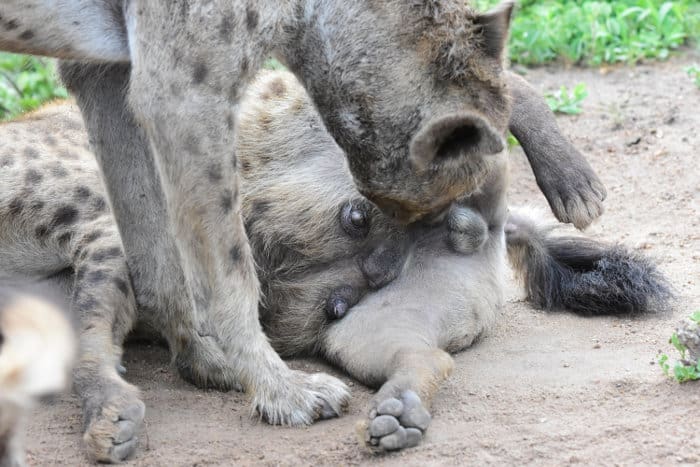
Both low-ranking females and males are submissive to the senior-ranked females. The male-like sexual organs help convey a hyena’s social status and enforce their position when feeding at a kill.
The nonadaptive hypothesis attributes the female’s genitalia to be an evolutionary by-product of high levels of androgens and testosterone.
These steroids made individuals aggressive and were likely responsible for the hyena’s female-dominant social structure.
The spotted hyena feeds in groups, with dominant females being the first to feast. A female with high-levels of testosterone would be most likely to survive and procreate. Leading to female hyenas evolving with high testosterone levels.
The sexual mimicry hypothesis relates to the idea of sexual monomorphism (where both sexes look the same). Female spotted hyenas benefit from appearing similar to males, as female hyenas experience a greater level of siblicide than males.
The high-ranking females occasionally kill the female offspring of lower-ranking females.
This behavior ensures the alpha female’s offspring will maintain hierarchy in the clan.
Females with male appearances would be more likely to survive and reproduce.
Other animals have pseudo penises, such as squirrel monkeys, lemurs, fossas, and binturongs (a cat-like carnivore).
Baby Hyenas

Spotted hyena cubs are black and grow into the lighter brown shade before developing spots. On the other hand, brown hyena and striped hyena cubs have the same body coloration as adults from birth.
Newborns receive nutrients from their mother’s milk and tend to suckle for an unusually long 12 to 18 months.
The newborn hyena is likely to taste its first meat from a kill near the den by five months old.
From one year old, the cub will join its mother on hunting and scavenging forays.
The hyena gestation period is long and allows the cub to be born with small teeth and open eyes.
Arriving in the world alongside a sibling can be detrimental. Young hyenas have sharp teeth and occasionally kill one another.
This behavior, alongside high-ranked females killing lower-ranked females’ cubs, means an estimated 25% of cubs die due to other hyenas in their first month.
Male vs. Female Hyena
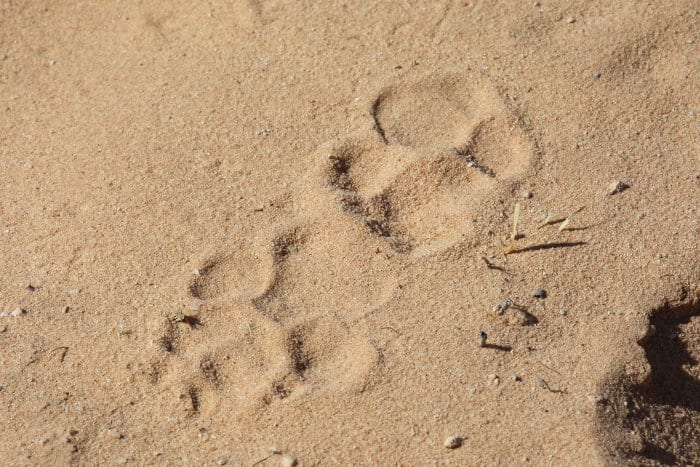
As mentioned above, the male and female spotted hyena have a similar appearance and external sex organs.
However there are differences in size and behavior, due to testosterone in female spotted hyenas appearing in levels three times as high as in males.
Both hyena genders receive exposure to high levels of male hormones during gestation — the testosterone transfers through the placenta and influences the cub’s development in the womb.
A spotted hyena clan is matriarchal, most often led by the oldest and most experienced female member.
The lowest-ranked female is always above the highest-ranked male.
In addition, the female cub of the alpha female can outrank lower positioned adult females.
Adult spotted hyena footprints are between 89-96 mm wide. The main pad is large, and its claws leave a significant imprint.
Despite the female footprints appearing the same as ones produced by males, the trackers can guess the sex of the hyena by the size and weight required to make the print.
Where to See Hyena Birth in the Wild?

Spotted hyena appear on safaris across sub-Saharan Africa.
The best locations to see clans of these carnivores are Botswana, Kenya, South Africa, Tanzania, Zambia, and Zimbabwe.
Keep an eye out for burrows with bones near the entrance, these are the tell tale markings of a hyena den.
A late evening game drive will give you the best chance of seeing a hyena resting with her cubs amongst the protection of clan members.
Guides are essential on safari and know the location of most of the dens in the nature reserve.
However, as mentioned above, stay alert for a once-in-a-lifetime chance of witnessing a hyena birth take place in the open.
Hyena Facts
- Female spotted hyenas are the largest of the species.
- On hot days, hyenas often cool off in mud wallows.
- Hyena droppings turn bone white – known as ‘bush meringues’.
- A common name for a spotted hyena is a laughing hyena for its distinct cackle.
- Hyena moms nurse young for around 14 months.
- Hyenas are members of the suborder Feliformia.
- Spotted hyenas are social and live in groups of up to 80 individuals.
- Hyenas can break large animal bones with their bite.
- A hyena’s stomach can safely process rotten flesh.
- They hunt for most of their food and occasionally scavenge kills from predators.
Choose Your Next Safari Destination Keeping Hyenas in Mind

Returning from a safari, you are likely to have awe-inspiring stories to share about the wildlife, nature reserves, and insightful guides.
Having learned about the spotted hyena’s painful and dangerous birthing process, you can appreciate this carnivore’s life even more.
Choose your next destination from the countries with spotted hyenas in mind, and keep an eye out for safari deals.
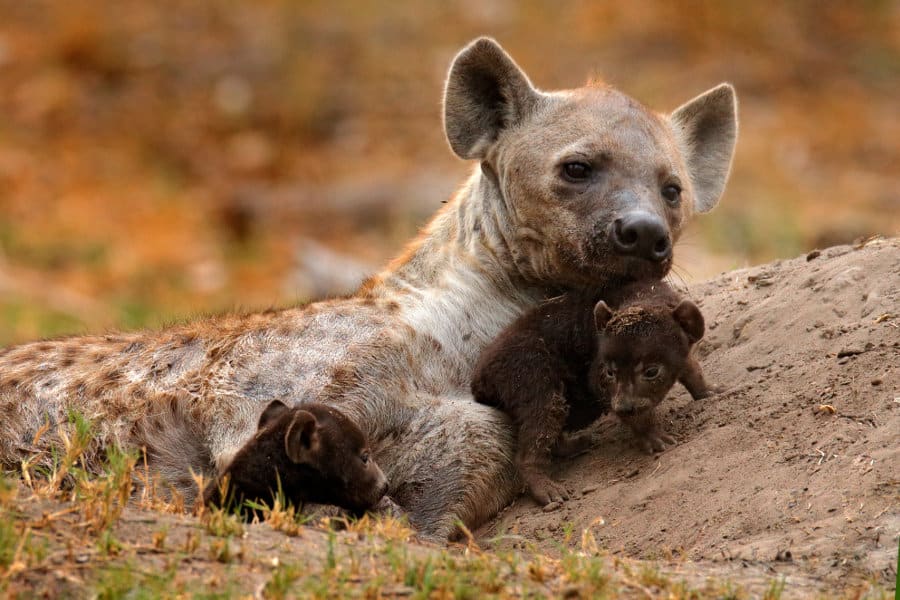


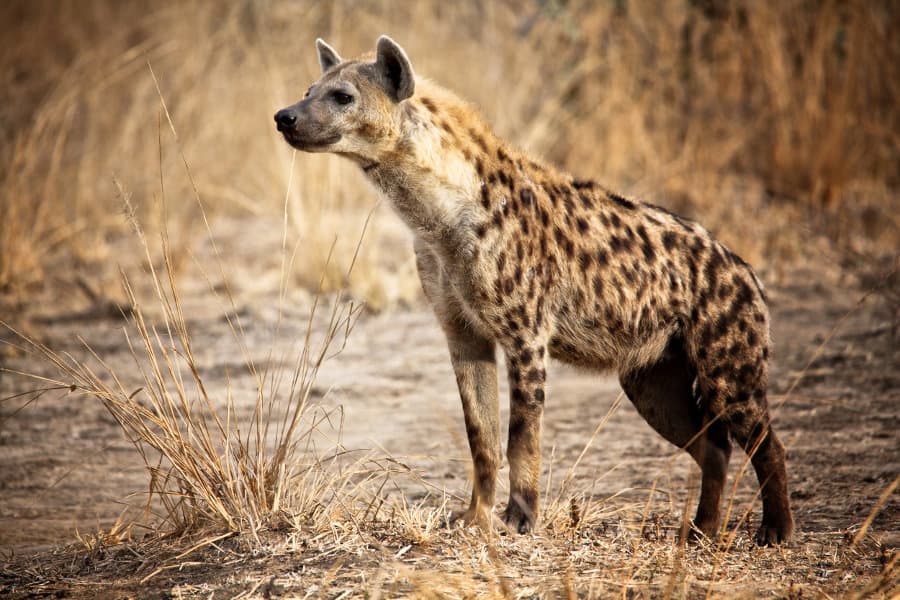
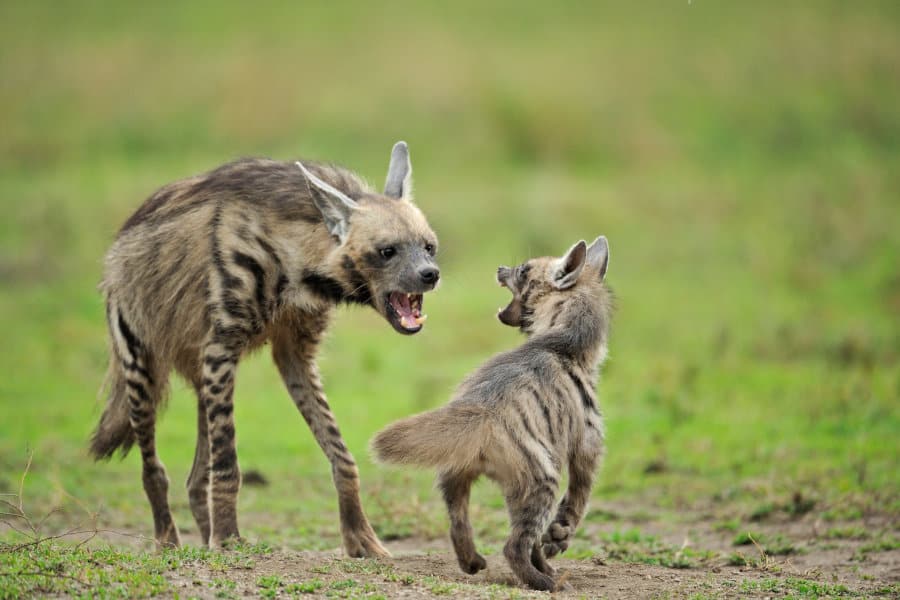
That is great information.